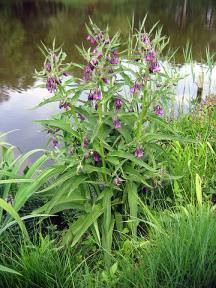Comfrey
 Common Name: Common comfrey, true comfrey
Common Name: Common comfrey, true comfrey
Scientific Name: Symphytum officinale
Climate: Temperate and cold
Plant Description: Comfrey is an herbaceous plant between 60 and 100 cm high, it is an evergreen with wide leaves and a bunch of purple bell-shaped flowers; it has a beet-shaped rootstalk, with black branched roots that have the thickness of a finger.
Cultivation: It prefers soil that is fairly moist. The ideal condition is when the rains come regularly throughout the year. This plant prefers semi-shade but is well adapted to direct sun. It requires a lot of nitrogen, it is recommended to add fertilizer before planting and from time to time to help its growth.
Comfrey reproduces easily from root cuttings. The cutting should be 5-15 cm of the root and planted horizontally 5-15 cm deep. Plant shallowly in clay soil and deeper in sandy soils. The cuttings should be planted at a distance of 50 cm, with up to one meter between plants. Keep the area moist while they are being established. It grows fast. It can be harvested five weeks after planting, by cutting it 5 cm from the root. Because it spreads by its rootstalk it can be harvested many times during one season.
Comfrey can live several decades before it begins to decline. Because of its deep taproot, comfrey is drought tolerant. However regular watering will keep it growing strong. Comfrey is a difficult plant to kill.
Uses: Comfrey is known as a companion plant (it has a beneficial relationship with other plants - repels pests). Its leaves can be used in the compost or as a cover around other plants, it is used as a green fertilizer.
The leaves serve as effective medicine for wounds and burns when used as a plaster. Ointment from the leaves helps to heal bone fractures, sprains, or dislocations of bones as well as joints and tendon problems. An infusion can be applied to the area of skin to be treated on chafing and open wounds. In case of external infection the area can be washed with it. In case of throat infections, this infusion can be gargled. The infusion is also very useful for healing nipple cracks in breastfeeding mothers. Comfrey has been used directly or as part of the composition of creams and ointments to heal wounds, relieve burns and reduce inflammation of haemorrhoids.
Pests and Diseases: Comfrey rust is the only problem. It is a fungal disease that can be detected by presence of small orange spots under the leaves, spreading to cover them and eventually sending out spores to infect other plants if detected early the leaves can be cut off at ground level and disposed of in dustbin rather than compost.
En español: Consuelda
